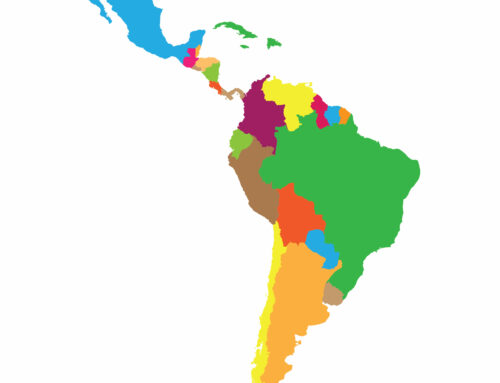“You can know every word in a sentence and still not understand”
That’s what the coordinator said to me when I was teaching English in Mexico to post graduate students.
You know what…
She was right, it can happen.
But she believed lack of comprehension was always about grammar and I believed it almost always about words.
You see, if you don’t understand a written sentence, it’s almost always because you don’t know a word. And if you know all the words in the sentence but you still don’t understand, 9 times out of 10 it’s still about the words.
More often than not, it’s not the grammar that stumps you, at least not the grammar that is usually taught.
Let me explain…
It’s the way words are combined to create different meanings that’s often the comprehension killer.
These are called collocations and they are one of the biggest stumbling blocks to comprehension, yet, they are almost never taught.
Let me show you what I mean.
Do you know the meanings of these words? mucho, bien, más, cuando, dar, quiere, cada, como, luz, decir, no, una, si, vez, caer, cuánto, tener, de, que
Most of the words look very familiar right?
How many do you know?
I expect you know at least 10-15 of those words, probably more.
What if we put the words together, do you know the meanings of these word combinations?
cuando mucho
cada cuánto?
dar a luz
tiene que
caer bien
como no
cómo si
de una vez
quiere decir
más bien
Here’s a tip: the meanings are very different from the individual words.
If you don’t know the combined meaning you’ll get confused about what people are saying to you.
Spanish will seem faster than it really is.
Here is an easy solution to building you mental database of collocations.
All you have to do is have someone point them out to you, then learn them as you would individual words.
If you learn them so well that you recognize instantly, you’ll make a big improvement to your ear for Spanish.
So, what did those combinations mean?
It may surprise you…
cuando mucho – at the most
cada cuánto? – how often?
dar a luz – to give birth to
tiene que – have to/has to (you should know this one)
caer bien – to be fond of/to like
cómo no – why not, of course
como si – as if
de una vez – once and for all
quiere decir – mean/means
más bien – rather/instead
Yikes,
Some combinations seem to have nothing to do with the individual words.
Could collocations be more important to understanding Spanish than they are given credit for?
Is it possible that this is more important than the usual grammar…
I believe so…
Let me tell you how I got a handle on the most important collocations.
When I was learning Spanish and kept seeing or hearing a collocation, I’d find its meaning and make a flashcard. I’d put the Spanish collocation on one side, the English meaning on the other. I also used to also make up a mnemonic to help me remember.
Then, next time I read or heard it again, it would spark my memory. I’d have a feeling of familiarity with the meaning. It only took me one or two times of hearing or reading it for it to sink in. After that, I would remember the meaning of many of the collocations forever, especially the more frequently used ones.
Here’s the bad news.
I used to make the cards with Rolodex cards. Then, I would carry some and store the rest in a plastic box.
You know where this is going right?
Yep.
Spring cleaning
“I guess I’m done with these cards? I know the meanings now”.
Oops.
How helpful they would have been to share with you
Not all is lost though. For the last year I have been busy cataloging collocations. Actively listening for the most universal (all regions) and the most commonly used ones to share with my students.
I’m going to put the most common ones into a PDF and share them with you, gratis of course.
It’ll help you build a solid database of the most common collocations and improve your understanding of Spanish.
Over the coming months, I’ll be sharing more extensive information on this and 6 other ways you can build your comprehension of Spanish.
If you signed up for my Spanish Ear Training information, look for emails about the reports. If not, you can join the update list for my here.
Also, I’ll be soon opening a Spanish Ear Training Coaching Program for just a few people. We’ll have even more details of these hidden secrets to comprehending more Spanish. Plus, members will have access to step by step methods to actively build their understanding of Spanish every month.
I’ll have more details on the program shortly.
Please leave your comments.









Thanks Marcus. That was really interestsing. I am really enjoying the course. I love the way you have set up the course. It is so easy to follow and easy to learn. I am very excited about learning Spanish. I would love to know
where to obtain the list of common collocations. Many, many thanks. Genevieve Swann Melbourne Australia
You can get them here:
https://synergyspanish.com/free-spanish-dictionary-of-idioms/
thank you for the courses i have completed and the free lessons. I have improved beyonf belief and i keep revising everything because of limited opportunity to practice apart from skype with two friends in spain.
the habit of eliding two words if one ends with a vowel and the next begins with a vowel. This is a HUGE comprehension killer that has never been addressed in this course. Why not, I wonder?
A BIG comprehension killer that is built into spoken Spanish but is never mentioned in this course: : the custom in Spanish of eliding two words if one ends in a vowel and the following one starts with a vowel, How are we supposed to understand when they do this? I would appreciate a comment on this. Thanks!
Thank you so much for putting this list together. I really do appreciate all the work that went into it. Collocations (although I did not realise that is what they are, at the time) have been a huge block for me so I am so grateful for this. Thanks again. Helen
Hola otra vez Marcus,
Thank so much once again for yet more information to help broaden my understanding of the Spanish language. I am so looking forward to puting these points into practice.
Saludos
Janet
what’s the difference between collocations and idioms or idiomatic expressions? i don’t mean to be a stickler for detail but curiosity is my motive.
Hola Marcus (I’m practising)
Though I did not have any problem as yet, I appreciate this informacion. I wanted to use the Spanish for ‘appreciate’ but I was unsure of the conjugation so, perhaps, next time.
Muchas gracias!
Ann
Thank you so much for the work that you are doing Marcus. I am now a resident of Mexico and have found a beautiful compañera who is learning English. We share the problem mentioned above in BOTH languages. Yesterday I said to her “common” (meaning to say “Come on”) and she asked “what does that word mean and how do you spell it?” It will take time for us to learn each others collocations and colloquialisms. But we have learned the key for us is to speak clearly and distinctly and “NOT SO FAST !!! :}
On a side note – She speaks Mexican and I speak American.
Marcus, until you can come up with some good lessons on how the Spanish speakers really speak by combining their words, I am still going to be in the dark. For example, they say “dondesta” instead of “dónde está”,”cuan doi ba mos” instead of “cuando íbamos”, “miul ti mo” instead of “mi último”. Well, you get my meaning. I love all of your other lessons and they have helped me tremendously. Thanks. Jim
This is going to be really useful for me when I get the time to sit down with it. Thanks very much
The free lessons you send me has helped me alot. I now can write some sentences instead of only knowing spanish words. Thank you very much.
I applaud the writer.
Marcus, gracias por todo ayudo. thank you again. I had never heard of collocations before you explained. I hope to join you at a later date.
joan
Small steps, but go a long way to understand and enjoy the pleasure of learning the glorious language of Spanish. God bless you.
Thank you for the Spanish Beyond the Dictionary part 2. Where would you locate part 1? I never received this. I would love to join Spanish Ear Training but I know I am not up to this level yet. I will hold on to your e-mails for future consideration. thank you Marcus.
gracias, me encanta tu pagina, es divertida e instructiva, si alguien desea practicar conmigo, puede hacerlo. Becky
Spanish is actually my third language, after English and German. I had a lot of trouble with German because I learned it in College, the old way, by grinding out every word individually and every verb conjugation “vertically”. What a drag!
I hope your students realize this “horizontal” way you teach is by far the most practical, quickest, most logical, efficient and natural way to learn anything, especially language, and I think mathematics too.
These collocations are another in your fine system of learning aids which I really believe in. And although there is some hard core memorization involved, it’s so well worth it that I find it enjoyable to learn this way. Thank you for all the thought and work you and Elena have put in to your method to make learning Language so much easier than it ever used to be. Muchas gracias, Lee Paul
Hi Lee
Thanks for the comments and the reminder to me to again emphasis the importance of horizontal approach. It’s one of my biggest teaching breakthroughs. It makes even the most complex Spanish attainable. Great that you appreciate it.
Marcus
I am quite excited to start this program because I have difficulty with that exact topic. When do we begin Marcus?
I Look forward to every email and all information that you send….
Languages, and especially Spanish, are my passion.
Can’t wait to see if it works for me. It will be just what I need so I let you know as soon as I get started
Mary
I hear you Marcus. I like the way you think. I like your creativeness. You perceive a problem and go to work on it.
I gave up my spanish school coz i never learn anything..thanks for having this lesson marcus you teached us a lot.
looking forward to the collocations gracias Dave
I am ready to roll! How can I purchase this now!
Marcus, I signed up for the first two months of your spanish ear training and loved every minute of it! I canceled my subscription in my attempt to cut back on expenses but I find that I really miss your methods and want to start up again soon. Please let me know if you have some sessions that are more advanced…I will cut back on something else so that I can continue learning with you! Gracias. Lucie
The collocations are interesting, but can you show us how to use them in a sentence?
Marcus, just wanted to say how much benefit (massive amounts) Im getting out of Synergy Spanish/Bola De Nieve. Really looking forward to more of this Spanish ear traning business?!
Cheers, Billy (Sydney, OZ)
¡Mil gracias!
Martín
Please teach more collocation. Its just what I have been looking for. I learned more from you in 1 lesson than I have in 3 months in a language school. You are a genius in teaching language.
Hi Marcus, I am unfamiliar with blogs. I just found yours. I am slowly studying “How-to-speak” You were going to give us transcripts for Lecions 8-31 audio. I have somehow missed receiving them. Is it too late for me to get them now? I love to learn Spanish when I feel well enough. Thank you for your help. Betty
Your approach makes complete sense to me. I enjoyed learning some Spanish at school many years ago, and have just completed a year’s beginners course at my local college. I’m just starting another one year course, at the end of which I hope to gain a GCSE/”O” level (Nationally recognised subject qualification in Britain, which you do usualy at the age of 16yrs at school). More importantly though, I want to gain some real spoken fluency.
Going back to Spanish after such a long break, I was amazed to discover that what I remembered most were the commom idioms and everyday phrases, just as you’ve described: e.g. “Yo creo que…”, etc. These “building blocks” can make you sound quite fluent, even when you only have a limited vocabulary!
I look forward to joining ASAP(!)as I know that it will be really useful to me. Many thanks, Anne
I missed it too. But, I would like to know how to access the letter that answered questions. I read about it in the second email but could not figure out where it was. If someone could tell me where to find it, I will be ready for the next class with all my questions asked before hand. Thanks
Wanted this badly but missed the window of opportunity. When, oh when will the next window open? Make it soon! Janece
cannot wait – why can I not have it now?
Mr Sanatmaria,
Thank you so much for your extremely helpful insight into the acquisition of the language. Icing on the cake!!!
It has been a great help to work with your audio courses and be understood enough to get by in my business visits to Spain
Thank you Marcus, I can’t wait for the next programme.
Best wishes.
Hi Marcus,
Your work has been of considerable assistance to us.
Muchas gracias.
Philip Nash
Marcus
Just a few words to confirm what everyone else is saying.We know (muchas palabras) but can’t make sentences,don’t here much spanish in England
Your steps to teaching is extraordinarily good. I can now make simple sentences without mistakes. My problem of inability to capture properly a spoken spanish from the experts as they speak would be likely resolved by the use of this new method. You are really good. Gracias
You are without doubt the best accident (I literally stumbled onto your site) that has ever happened to me!
All of the above and the little poem too! :O)
just want you to know that i am looking forward!
Collocations! What a word
A secret that’s within
And Marcus will reveal to us
So it won’t be so grim
Traducion of collocations
Now really I must say
I really want to ask you Marcus
How I’d say Oi Vay!!!!!!
Muchas Gracias to Marcus
This man has the key
To make us Spanish speakers
Adios from little old me!
thanks Marcus, i am greatly looking forward to this next step in comprension – my skills in reading writting and speaking in spanish have all improved dramaticaly with your courses – my big weakness is the understanding of the spoken words in normal conversations – cant wait to enroll – cheers
Its a big opportunity to us to learn more Spanish,thank you very much for the non stop support.God bless always and more power.
¡Hola! This is exactly what I need. Puedo escribir y leer español un poco, pero no puedo entender español cuando lo oigo. I am sure I have made some mistakes. Espero que usted me entienda. ¡Muchas gracias!
Going down your individual list of words, I thought to myself, I know all of these. Then when it came to
your list of collocations, Yipes! What a eye opener your list was. I said to myself, “Oh my God”, is this what the combination of these words mean. Wow, I really need this training. Thank you for putting this together for me and the others who are eager to learn Spanish proficiently.
Well, I can only say thank you for switching on that little light of comprehension, as I am sure it was the same for many. I know “muchas, muchas palabras”, however, it “is” the meanings of “word combinations” that have stented me from learning to speak Spanish more proficiently.
Thank you Marcus, your bringing me closer to my goal!
Thank you Marcus, SOOOO much for all your input into helping us all with our Spanish. There are so many great comments already, it is hard to think of any more! Just thanks again and please know how grateful we all are for your hard work.